Summary
The story of this tragic voyage highlights the strong historical, family and scientific connections between Largs and Brisbane, Western Australia. Mr David Guthrie Dunn of Knock Castle, Largs was a very accomplished sailor who named all his yachts ‘Southern Cross' due to his fascination with the southern seas. The young tobacco heir set sail from the Clyde in his new yacht Southern Cross to circumnavigate the globe in October 1930, and arrived in Brisbane a year later. He embarked on the return leg of the journey in June 1932, but was tragically lost at sea between Cape Town and St Helena. In his honour, the Dunn Memorial Hall was gifted to the congregation of St John's Church in Largs.
Dunn Family and Knock Castle
Mr John Dunn was a tobacco merchant and partner in the prominent Glasgow tobacco manufacturing company F & J Smith. The firm was amalgamated with other companies and became part of Imperial Tobacco in 1901. The family home Knock Castle was built by the boat-building Steele family in 1851, and acquired by John Dunn in 1915.
David Guthrie Dunn, the younger son of John Dunn, was left a large inheritance by his father and with it he was able to indulge in his great passion for yachting. D Guthrie Dunn, as he was known, was an active member of four yacht clubs and became one of the most prominent young yachtsmen on the Clyde. While he was still a student at Cambridge University he developed a meticulous plan to build an ocean going cruising yacht and sail round the world. Just five months after graduating with a BA in May 1930, at the young age of 23, he set off on his grand adventure with two university friends, Mr James Shackleton from Yorkshire and Mr W G Penman from Dumfries.
Southern Cross
Guthrie's new ocean-going yacht was the third to bear the name ‘Southern Cross', after the constellation, the others were sleek racing yachts; a 6-Metre, and an 8-Metre. He also owned a large steam yacht named Northern Lights and a speed boat called The Knock , which was raced successfully in Scotland and at a London to Cowes event.
The Southern Cross was specially designed by the renowned Scottish naval architect G L Watson & Co for this challenging round the world voyage. The 51 ft auxiliary ketch was built at the boatyard of Alexander Robertson & Sons Ltd of Sandbank (Nr Dunoon), which was well known for the quality of its workmanship. She was soundly constructed of teak with a wide beam of 14.5ft, there were three comfortable cabins below, and she could be steered from a forward wheelhouse or the aft cockpit. Extra-large water and fuel tanks were fitted to allow the cruising range to be extended. |
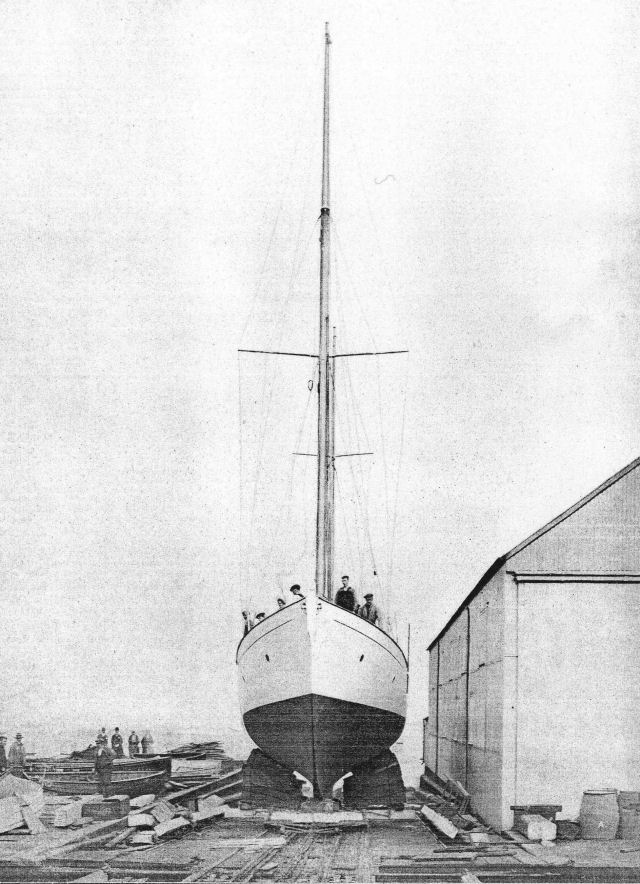 |
Southern Cross being launched into the Holy Loch at Robertson's Yard, Sandbank (near Dunoon), 18 August 1930.
Photo: The Yachtsman & Motor Boating Magazine.
Note: Four recent photos the author has taken of the Southern Cross in Mallorca will be found at the bottom of the article. |
Some initial sea trials took place after the yacht was launched into the calm waters of the Holy Loch on 18 August 1930. A few days later she embarked on a cruise to Ireland to assess her ocean-going performance, before setting out on her long voyage to the South Seas.
Brisbane
The crew of Southern Cross headed for Brisbane, because there were strong family, historical and scientific links between the state capital of Queensland and Largs.
Thomas Brisbane, son of Sir Thomas Brisbane and Dame Eleanora Brisbane, was born at Brisbane House, Noddsdale near Largs in 1773. He received an extremely good general education at home and in London before taking up a commission in the army at the age of 17. He saw active service in both Europe and the West Indies. After one disastrous Atlantic crossing with his regiment in 1795 his ship ended up off the coast of Africa rather than the West Indies. As a result, Brisbane resolved to learn more about astronomy so he could navigate at sea. Whilst on temporary leave from the army between 1805 and 1811, he built an observatory at Brisbane House in 1808, which was only the second one in Scotland at the time. His interest in astronomy became a lifelong pursuit, and his subsequent observations and studies made a significant contribution to the advances in navigation which took place over the next hundred years.
At the end of the Napoleonic Wars he sought employment which would allow him to continue his interest in astronomy and navigation. The new Sir Thomas Brisbane became the 6th Governor of New South Wales in 1821, and he immediately set about establishing a private observatory in the grounds of Government house at Parranatta, using much of the equipment from his observatory at Largs. The town of Brisbane, the Brisbane River, and the Sir Thomas Brisbane Planetarium were all named after him.
Brisbane left Australia in December 1825 and returned to Scotland. He settled down to the life of a country gentleman and took an interest in his estate, his regiment and astronomy. He built his third observatory at his wife's family estate at Makerstoun, near Kelso, and employed a team of scientists throughout the 1840s. After a very distinguished military/scientific career he died in 1860 and was buried in the Brisbane Vault, which is in the small graveyard next to Skelmorlie Aisle, Largs Old Kirk.
The name 'Brisbane' appears widely throughout Largs: Brisbane Glen; Brisbane Queen Festival, which started in 1936; Brisbane House Hotel; local businesses; a bridge; and street names.
Round the World
On 26 October 1930 Southern Cross set sail on her 20,000 mile voyage round the world with a crew of three young, but experienced yachtsmen. During the early part of the trip across the Bay of Biscay, they encountered severe storms for several days and had to seek sanctuary in Corcubión, in the north-west tip of Spain. They eventually set off across the Atlantic from Tenerife and made their way safely to Trinidad.
While visiting Jamaica, they had an interesting encounter and poignant reminder of their links back to their home waters on the Clyde. They came across the famous steam yacht SY Nahlin , which was owned by the jute heiress Lady Yule of Glasgow, and built by John Brown & Co at Clydebank. This elegant 296 ft yacht, which required a crew of over 50, had the same designer as Southern Cross - G L Watson & Co of Glasgow. In addition, the owner's luxurious 30 ft motor launch, crew's launch, 2 lifeboats and two dinghies for the SY Nahlin were built by Alexander Robertson & Sons Ltd of Sandbank, that also built the Southern Cross.
After passing through the Panama Canal they made their way across the Pacific, stopping at several islands on their way. They arrived in Brisbane exactly one year after they set sail from the Holy Loch. Guthrie Dunn returned to the UK by steamer to attend to the estate of his father, during which time the Southern Cross was dry-docked and overhauled for the journey home. He returned to Brisbane in June 1932 to resume the adventurous voyage with his two friends. |
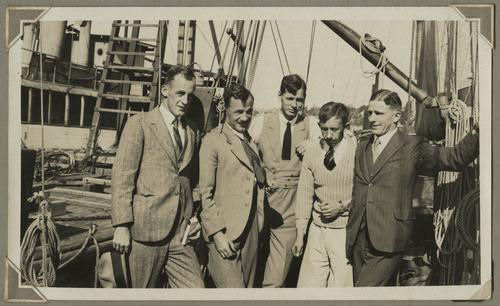 |
The three man crew of Southern Cross in the centre, Brisbane June 1932 - James Shackleton (navigator) on left, D Guthrie Dunn (owner/skipper) in the middle, W G Penman (engineer) to the right.
The photo is part of the Campbell family collection held in the John Oxely Library by the State Library of Queensland. Apparently somebody in a local Campbell family took photos of many yachts in the harbour. The Southern Cross coming all the way from the birthplace of Sir Thomas Brisbane would have created quite an interest in those days. |
|
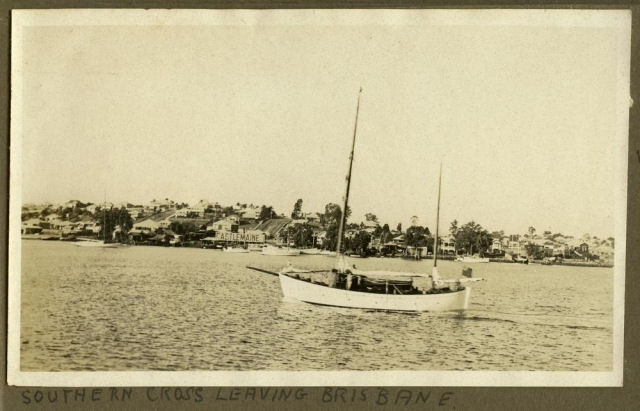 |
Southern Cross Leaving Brisbane (Courtesy John Oxley Library, State Library of Queensland)
|
|
|
Making their way past the Great Barrier Reef, they visited Mauritius and Madagascar before arriving in Cape Town. In February 1933 they set off for the challenging Southern Atlantic leg to St Helena. While on watch on the night of 8 March, during heavy seas, Guthrie Dunn was lost overboard. The yacht arrived in St Helena, with the remaining crew of two on 16 March, where an enquiry was held.
Dunn Memorial Hall
A memorial service took place at St John's Church Largs on 25 March, which was attended by close family, all sections of the local community, and many prominent Clyde yachting personalities, including: Mr W Smart, representative of G L Watson, designer of Southern Cross ; Mr Alex Robertson and Mr George Robertson, Sandbank, builders of the boat. It is sad to note that Guthrie Dunn's elder brother John was also lost at sea, while rowing off Knock Castle in 1923, when he was just 18 yrs old.
Ownership of Knock Castle passed out of the Dunn family in 1934. Guthrie Dunn left a large estate of £1.2 million and in February 1935 it was announced to the congregation of St John's Church that a gift of £2030 was to be made for the erection of hall in memory of D Guthrie Dunn. The Dunn Memorial Hall was presented to the church and opened on 25 March 1936 by Mr Thomas Stark Brown, legal representative of the estate of the late Mr D Guthrie Dunn.
Sailing on In April 1933 Captain William Ure from Largs set off on a steamship from London, with a replacement crew, to bring the yacht back from St Helena. A rather weather beaten Southern Cross finally arrived back at Robertson's boat yard on the Holy Loch on 8 July 1933, nearly three years after she was launched there.
The Southern Cross changed hands several times before she was bought by the Hull Fishing Vessel Owner's Association in the 1960's and used as a sail/navigation training vessel by them, and the local Nautical College. The yacht now under the name Cailach was sold and moved to the south coast of England. Around 1992 she left UK waters, and after an extensive renovation is now based in Mallorca.
It is my intention to continue researching the history of the Southern Cross and her voyage so any further information about the yacht or the Dunn family would be most welcome. robyardsb@hotmail.co.uk
Main References
- The Yachtsman & Motor Boating magazine, 21 March 1931 and 25 March 1933.
- Lloyd's Register of Yachts.
- Alexander Robertson & Sons Ltd Boatbuilders – Robertson family archives.
- Journal and Proceedings of the Royal Society of New South Wales. ‘Sir Thomas Brisbane – a man of scientific method' presented by Dr Carol Liston at the Symposium Commemorating Governor Sir Thomas Brisbane, National Trust, Observatory Hill, 1 st December 2011.
- Digital Collection, John Oxley Library, State Library of Queensland.
- Newspapers articles, various: Scotsman; Glasgow Herald; Brisbane Courier; Central Queensland Herald; Sydney Morning Herald; Windsor & Richmond Gazette.
Southern Cross Trophy - photo
The renowned Glasgow jeweller Robert Stewart, silversmith to Queen Victoria, was commissioned by D Guthrie Dunn in 1930 to produce a finely crafted sterling silver model of Southern Cross. It is believed that Dunn took delivery of the magnificent model in 1932, during his brief trip home. The mast is 60cm high and the detail so fine you can see all the fittings and beautifully coiled ropes on the deck. In 1965 Dunn’s cousin Miss Elizabeth B Mathieson donated the magnificent Southern Cross trophy to the Ayr Yacht Club to be presented to the winner of the ‘Ailsa Craig’ offshore race.
|
 |
Southern Cross at anchor in the port of Soller, Mallorca. |
|
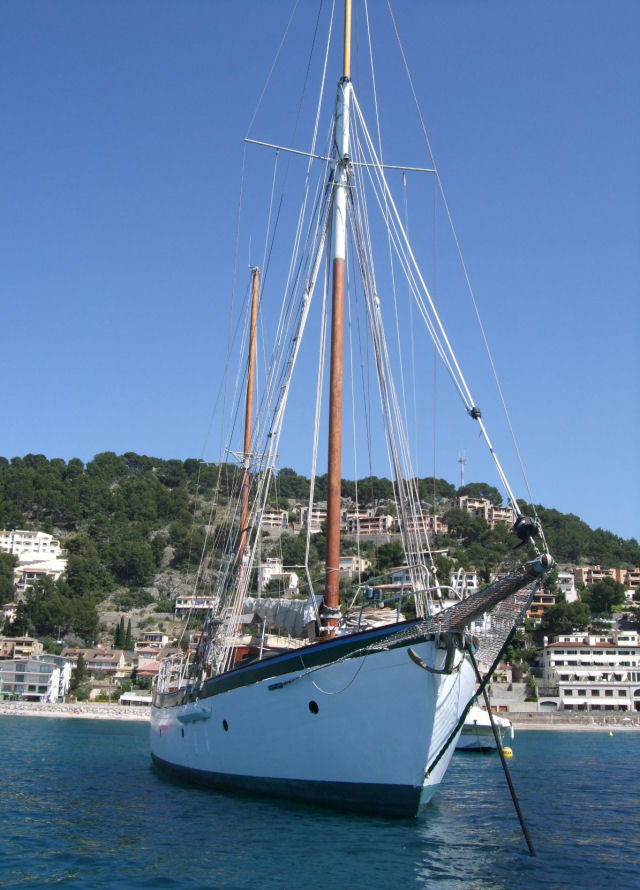 |
Southern Cross at anchor in the port of Soller, Mallorca. |
|
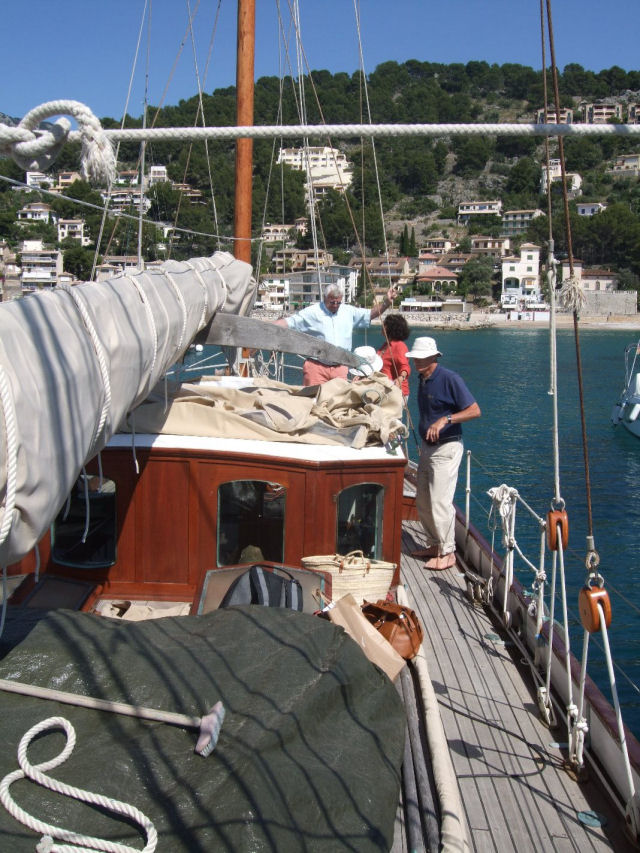 |
The owner in the blue shirt beside the wheelhouse. |
|
 |
Nameplate: Builder Alexander Robertson, Sandbank; Designer G L Watson, Glasgow. |
|
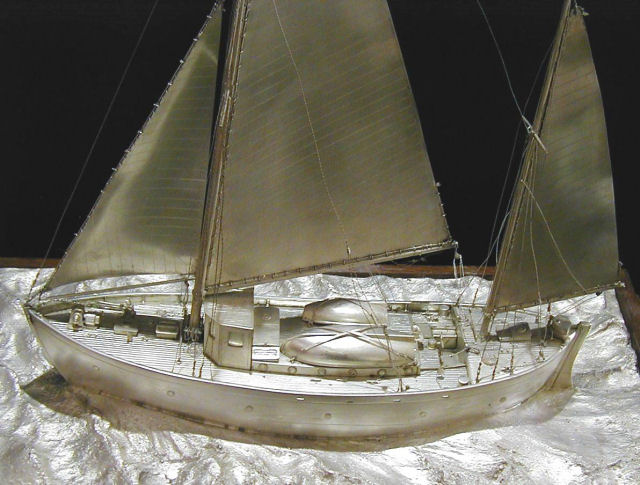 |
Southern Cross Trophy |
|
|